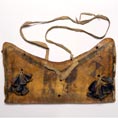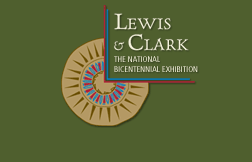
IMAGE GALLERY
 |
 |

Access the Image Gallery to see all images, objects, and documents used in this lesson plan.
 |
View Image Gallery

|

|
 |



Lesson Plan 2: What Role Did the Medicine Man or Woman Play among American Indians for Treating Illnesses?
OBJECTIVES
Students will:
- describe the role of the medicine man in American Indian society
- read and draw inferences from two American Indians' views on the medicine man
- compare American Indian medicine in the nineteenth century to its Euro-American counterpart
MATERIALS
BACKGROUND
 Jefferson asked Lewis and Clark to investigate American Indian medical remedies. Lewis noted in his journals how American Indians used plants as treatments. He cited the purple coneflower as an example. It grows on the prairie. Indians gathered its roots to treat a number of poisonous conditions, such as snakebites and bee stings, as well as toothaches. Lewis also cited the blanket flower, which is common on the western grasslands. American Indians used it to treat intestinal infections, skin problems, and kidney disorders. It was also used to make nose drops and eyewash. Jefferson asked Lewis and Clark to investigate American Indian medical remedies. Lewis noted in his journals how American Indians used plants as treatments. He cited the purple coneflower as an example. It grows on the prairie. Indians gathered its roots to treat a number of poisonous conditions, such as snakebites and bee stings, as well as toothaches. Lewis also cited the blanket flower, which is common on the western grasslands. American Indians used it to treat intestinal infections, skin problems, and kidney disorders. It was also used to make nose drops and eyewash.
As we learned in Lesson 1, Euro-Americans also used plants to heal. Where the two groups differed was in their spiritual beliefs. In her book Lewis and Clark: Across the Divide, Carolyn Gilman describes the Indian view as follows:
An Indian patient lived in an animate world, surrounded by entities who could make him ill if offended by some action or inaction. Snakes and lizards could invade the body. Animals killed without respect could visit illness on the hunter. Malicious sorcerers could send disease. The doctor's job was to identify the angry power, then overcome or placate it. The doctor's curing ability came not just from skills and knowledge, but more importantly from his or her spirit allies. The human being was only an intermediary through whom spirit power operated.
The Nez Perce believed that some illnesses were simple, "natural" occurrences, and those were treated with herbs. Every person learned about curative plants in adolescence, from his or her parents. A few medicinal plants were widely known, but most were privately owned: each family had its secret recipes. If someone outside the family wished to use such a medicine, the owner would prepare it for a price, paid in gifts after the cure was achieved. It was not strictly sacred knowledge, but it was private.
If herbs did not work, then the illness might be of another type, which called for the intervention of a doctor. This kind of sickness was caused by a moral imbalance or power struggle between animate beings. A person's spirit allies could desert him or her, due to some disrespectful action or the malice of an outside power. In such a case, diagnosis was the most difficult task for Indian doctors. But they did not ask "What disease is it?" They asked, "Who has caused it?" This question could only be answered by a person attuned to the spirit world, since the physical disease was only a symptom of an underlying spiritual conflict. Nevertheless, the treatment was often physical, since body and spirit were not separate things.
It is important to note that the medicine man or woman's role was more complex than this description, and much depended on the situation of the ill person and the curatives that the medicine man/woman applied. The cure was both physical and mental. The medicine man/woman had to decide when the illness or wounds could no longer be treated.
The following is a partial list of Indian plants and their medicinal purposes. The list is from the book Keepers of Life (Caduto, p. 238):
- dogwood reduces fever
- milkweed sap promotes healing and wards off infection. Milkweed root is used to treat coughs
- witch hazel sap boiled down is used for an astringent (a substance used to contract the bodily tissues and so diminish discharge, as of blood)
- Pacific yew is traditionally used as an anti-inflammatory by Indian peoples of the Pacific Northwest. Taxol, a powerful cancer-fighting drug, is extracted from yew bark
- salicin from willow, a chemical precursor to modern-day aspirin, is used to relieve headaches and rheumatism
- white pine tea made from boiling the needles has more vitamin C than orange juice. It is used to treat symptoms of scurvy and colds. White pine sap cures boils and abscesses
- ash bark is used to make a poultice for treating sores and hemorrhoids and for a tea that is an effective diuretic
- bark from the Cascara buckthorn is used by Pacific Northwest peoples as a cathartic laxative
- oot-bark tea from oak is an astringent, helps wounds to heal, and suppresses coughs
The following were not native to North America:
- quinine from bark of the Peruvian quina— quina is used to treat malaria
- the roots of three species of yams (Dioscorea) in eastern Mexico contain a steroid, diosgenin. This compound is used to create synthetic cortisone, a treatment for skin disorders, rheumatoid arthritis, and ulcerative colitis. From diosgenin scientists also learned to create birth-control pills
- procaine (Novocaine) and xylocaine are synthetic drugs patterned after the chemical composition of cocaine to produce similar anesthetic effects
- balsam root, from Balsamorhiza sagittata, is used to create a salve for healing wounds. The resinous bud coating on balsam poplar or tacamahac form the base for a healing ointment
OPENING
 Display the painting of "Old Bear, a Medicine Man." Have students answer the following questions: What is this man doing? What are the clues? Display the painting of "Old Bear, a Medicine Man." Have students answer the following questions: What is this man doing? What are the clues?
Explain that this is a painting of a medicine man by George Catlin painted in 1832. He is performing a ritual over a dying man. In many American Indian cultures, the healers are represented as people of the bear society. Bears eat a variety of plants, herbs, and roots. American Indians believed that the bears' foraging habits belied an innate understanding of the healing powers of various plants. Their healers spent years studying families of plants and believed that plants within particular families possessed the power to heal against specific classes of disease. The naming of many American Indian communities reflects their respect for healing powers; Medicine Bow Forest, Wyoming, and Medicine Hat, Alberta, are examples (Caduto, p. 239). However, "medicine" meant more than "healing." It was the equivalent of "holy" or "sacred" or "mysterious."
- as students view the painting, read (or paraphrase) the teacher background information above
- to illustrate how medicine men and women were misunderstood by Euro-Americans, have students read the following excerpt from Joseph Medicine Crow:
There were medicine men and medicine men, which is to say there were divisions, classes, and ranks in this profession. These were, of course, arranged differently from tribe to tribe, and from culture area to culture area, but they were basically the same. One thing is sure. This unusual and interesting individual was more than just the white man's stereotyped image of a character in weirdo costumes and paraphernalia, brandishing rattles and feathers, muttering unintelligible grunts, changing invocations, and jumping and hovering over a poor sick and scared person. More often he is depicted as deceiving his patient or subject with trickery and sleight of hand. It is said that he lived and thrived by imposing on the credulity of those who depended on him and by asking exorbitant fees. On the contrary, the average Indian medical or holy man was a decent sort, hardworking, sincere, aware of the seriousness of his responsibilities, and dedicated to the individual well-being and general welfare of his people and community. It is indeed unfortunate that the true image of this indispensable man of the tribe and his genuine and great contributions have been so long belittled, tarnished, and obscured by the ethnocentric white man.
Perhaps Joseph Medicine Crow was too sensitive to the slights of the Euro-Americans. It seems that Euro-Americans in the nineteenth century were suspicious of all doctors, regardless from what culture they came. President Jefferson criticized the Euro-American doctors as a "presumptuous band of medical tyros let loose upon the world" and relied instead on prevention and folk cures. Also, Euro-Americans thought that Indians were very skilled at healing and often used their remedies.
Indians used not only plant cures, but also a whole variety of approaches to healing, including songs, prayers, and steam baths.
In short, the simplest way to understand the contrast between the two approaches to medicine is this: Euro-Americans had a mechanical model of the body, while Indians thought of it in spiritual terms (Gilman, chap. 8).
PROCEDURE
- Ask how the American Indian medicine man/woman differed from Dr. Rush.
- Show a picture of the parfleche medicine case of the Nez Perce. Explain that this bag at one time may have held curing plants. The paintings on the outside of the bag were as important as the plants inside. The decorations on the bag depicted spirits and the spiritual causes of the illness. Also show the image of the Medicine Woman’s Outfit along with its caption. It is important that students understand the various kind of tools represented.
- Ask students to compare the Nez Perce medicine bag to the photograph of the nineteenth century Euro-American medicine chest. Ask students to compare the Nez Perce medicine bag and the medicine woman’s outfit to the photograph of the nineteenth-century Euro-American medicine chest. Recall Dr. Rush's rules.
- what differences do you notice between the two medicine kits?
- what do you think the Nez Perce carried in the medicine case? (Answer: natural remedies from various species and parts of plants.)
- how is the medicine woman’s outfit different from the medicine box brought by the Corps of Discovery?
- Make a list describing Euro-American versus American Indian approaches to healing. Have students work on a list individually (or in small groups) and then discuss as one big group. Draw a Venn diagram (two concentric circles—with Euro-American Perspective within one circle and American Indian Perspective within the other circle). Place any similarities between the two groups in the overlapping sections. Ask which, if any, beliefs the two cultures shared. You should emphasize that while both groups shared a common knowledge of using herbs as remedies, they differed on the cause of serious illnesses. The Euro-Americans thought these were caused by poisoned fluids that had to be expelled. The American Indians thought they were caused by spiritual errors that had to be corrected.
CLOSING
Have a class vote: Suppose you were living in the 1800s and needed to be treated by a doctor for a serious illness. Which doctor would you want to cure you? Dr. Rush or the medicine man? Why? (There are no wrong answers here.)
SUGGESTED FORMATIVE ASSESSMENT
To be assigned as homework: written assignment where each student chooses his or her doctor and explains why.
[PRINTABLE VERSION]
|
 |








